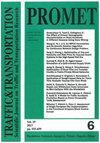Asymmetric Behaviour and Traffic Flow Characteristics of Expressway Merging Area in China
IF 1.1
4区 工程技术
Q4 TRANSPORTATION SCIENCE & TECHNOLOGY
引用次数: 1
Abstract
Drivers show different characteristics in traffic oscillations. These differences reflect the driver’s driving style, which is an important part of traffic uncertainty. This paper deeply explores the driving characteristics in asymmetric driving behaviour and its influence on traffic flow characteristics. The aim is to improve the understanding of safe driving. Continuous vehicle trajectories under various traffic flow conditions in an expressway merging area are obtained by aerial photography. Image processing technology is used to extract the basic parameters of traffic flow and vehicle operating characteristic data. Based on the measured data, the driver’s response mode is subdivided into multiple sub-modes. On the basis of this study, the types and distribution of traffic hysteresis and the impact of asymmetric behaviour on merging area capacity are further revealed. The results show that the response coefficient will increase for 58.72 % drivers during the process of experiencing oscillation disturbance to rebalance. The traffic hysteresis caused by driver’s asymmetric following behaviour in an expressway merging area is generally positive. This reduces the bottleneck outflow rate of the merging area by about 7 % on average. This study has important practical significance in analysing the formation mechanism of traffic congestion and adopting effective protective measures.中国高速公路合流区不对称行为与交通流特征
驾驶员在交通振荡中表现出不同的特征。这些差异反映了驾驶员的驾驶风格,这是交通不确定性的重要组成部分。本文深入探讨了非对称驾驶行为下的驾驶特征及其对交通流特征的影响。目的是提高对安全驾驶的理解。利用航空摄影技术,获得了高速公路合流区内不同交通流条件下的连续车辆轨迹。利用图像处理技术提取交通流基本参数和车辆运行特征数据。基于实测数据,将驾驶员的响应模式细分为多个子模式。在此基础上,进一步揭示了交通迟滞的类型和分布,以及不对称行为对合并区容量的影响。结果表明,58.72%的驾驶员在经历振荡扰动再平衡过程中响应系数增大;高速公路合流区驾驶员不对称跟随行为引起的交通迟滞一般为正。这使得合并区域的瓶颈流出率平均降低了7%左右。该研究对于分析交通拥堵的形成机制,采取有效的防护措施具有重要的现实意义。
本文章由计算机程序翻译,如有差异,请以英文原文为准。
求助全文
约1分钟内获得全文
求助全文
来源期刊

Promet-Traffic & Transportation
工程技术-运输科技
CiteScore
1.90
自引率
20.00%
发文量
62
审稿时长
3 months
期刊介绍:
This scientific journal publishes scientific papers in the area of technical sciences, field of transport and traffic technology.
The basic guidelines of the journal, which support the mission - promotion of transport science, are: relevancy of published papers and reviewer competency, established identity in the print and publishing profile, as well as other formal and informal details. The journal organisation consists of the Editorial Board, Editors, Reviewer Selection Committee and the Scientific Advisory Committee.
The received papers are subject to peer review in accordance with the recommendations for international scientific journals.
The papers published in the journal are placed in sections which explain their focus in more detail. The sections are: transportation economy, information and communication technology, intelligent transport systems, human-transport interaction, intermodal transport, education in traffic and transport, traffic planning, traffic and environment (ecology), traffic on motorways, traffic in the cities, transport and sustainable development, traffic and space, traffic infrastructure, traffic policy, transport engineering, transport law, safety and security in traffic, transport logistics, transport technology, transport telematics, internal transport, traffic management, science in traffic and transport, traffic engineering, transport in emergency situations, swarm intelligence in transportation engineering.
The Journal also publishes information not subject to review, and classified under the following headings: book and other reviews, symposia, conferences and exhibitions, scientific cooperation, anniversaries, portraits, bibliographies, publisher information, news, etc.
 求助内容:
求助内容: 应助结果提醒方式:
应助结果提醒方式:


